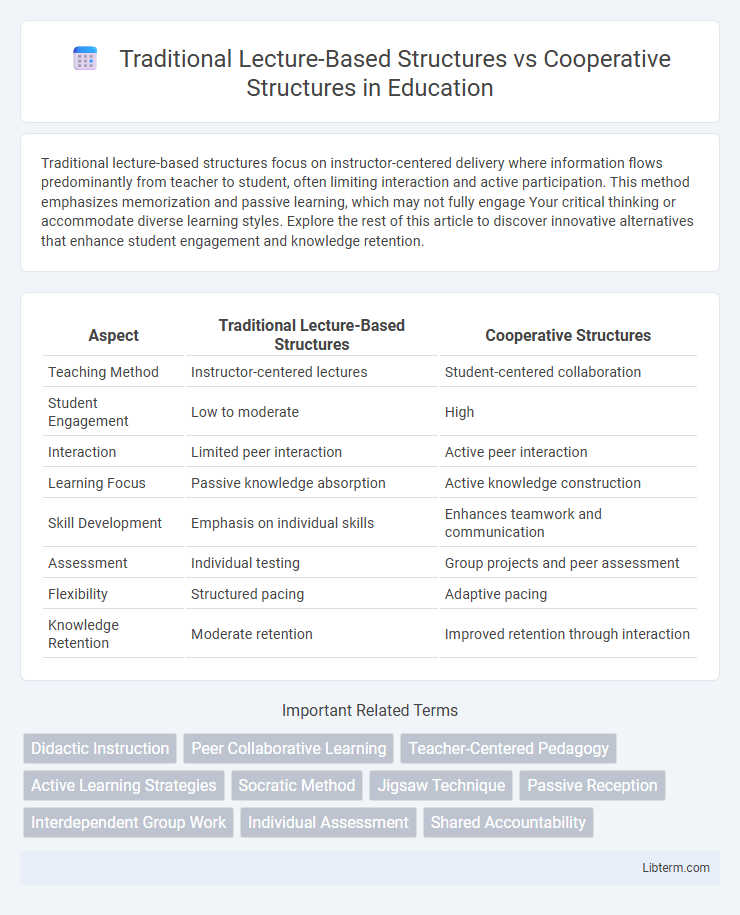Traditional lecture-based structures focus on instructor-centered delivery where information flows predominantly from teacher to student, often limiting interaction and active participation. This method emphasizes memorization and passive learning, which may not fully engage Your critical thinking or accommodate diverse learning styles. Explore the rest of this article to discover innovative alternatives that enhance student engagement and knowledge retention.
Table of Comparison
| Aspect | Traditional Lecture-Based Structures | Cooperative Structures |
|---|---|---|
| Teaching Method | Instructor-centered lectures | Student-centered collaboration |
| Student Engagement | Low to moderate | High |
| Interaction | Limited peer interaction | Active peer interaction |
| Learning Focus | Passive knowledge absorption | Active knowledge construction |
| Skill Development | Emphasis on individual skills | Enhances teamwork and communication |
| Assessment | Individual testing | Group projects and peer assessment |
| Flexibility | Structured pacing | Adaptive pacing |
| Knowledge Retention | Moderate retention | Improved retention through interaction |
Understanding Traditional Lecture-Based Structures
Traditional lecture-based structures center on a teacher delivering content to passive students through oral presentations, emphasizing memorization and individual learning. This model often limits student interaction and real-time feedback, impacting engagement and deeper comprehension. High reliance on lectures can challenge diverse learning styles, potentially reducing knowledge retention compared to interactive methods.
Key Features of Cooperative Learning Structures
Cooperative learning structures emphasize student collaboration through group problem-solving, shared responsibility, and peer teaching to enhance understanding and retention. Key features include positive interdependence, where each member's success is linked to the group's success, individual accountability ensuring active participation, and face-to-face promotive interaction fostering constructive communication. These structures promote social skills development and critical thinking by encouraging diverse perspectives and collective knowledge construction.
Historical Evolution of Educational Methods
Traditional lecture-based structures dominated early educational systems, emphasizing teacher-centered instruction and passive learning, rooted in ancient academies and formalized during the Industrial Revolution to efficiently transmit knowledge to large groups. Cooperative structures emerged in the 20th century, influenced by progressive education theorists like John Dewey and Lev Vygotsky, who advocated for active, student-centered learning and social interaction to enhance critical thinking and collaboration skills. The historical evolution from rigid lectures to dynamic cooperative models reflects shifting societal values towards inclusivity, engagement, and the development of 21st-century competencies.
Student Engagement in Traditional vs Cooperative Classrooms
Student engagement in traditional lecture-based structures often remains passive, characterized by note-taking and limited interaction, which can hinder deep comprehension and critical thinking. In contrast, cooperative classroom structures actively involve students through group discussions, collaborative problem-solving, and peer teaching, significantly enhancing motivation and participation. Research consistently shows that cooperative learning environments lead to higher retention rates and greater overall student satisfaction compared to traditional lecture formats.
Teacher Roles: Lecturer vs Facilitator
In traditional lecture-based structures, the teacher assumes the role of a lecturer, primarily delivering content and controlling the flow of information to students. In contrast, cooperative structures position the teacher as a facilitator who guides collaborative learning, encourages student interaction, and supports critical thinking. This shift from authoritative instructor to interactive facilitator promotes active engagement and deeper comprehension among learners.
Impact on Knowledge Retention and Comprehension
Lecture-based structures often result in passive learning, which limits knowledge retention and deep comprehension due to minimal student interaction and engagement. Cooperative structures promote active participation, peer collaboration, and discussion, enhancing critical thinking and long-term understanding of material. Research indicates cooperative learning leads to higher achievement scores and improved ability to apply knowledge in practical contexts compared to traditional lectures.
Assessment Techniques in Both Structures
Assessment techniques in traditional lecture-based structures primarily rely on individual exams, quizzes, and written assignments that emphasize memorization and recall. In contrast, cooperative structures utilize formative assessments such as peer evaluations, group projects, and collaborative presentations to measure interpersonal skills and collective understanding. Both approaches integrate summative assessments, but cooperative methods often incorporate continuous feedback mechanisms to enhance student engagement and learning outcomes.
Benefits and Limitations of Lecture-Based Learning
Traditional lecture-based learning offers benefits such as the efficient delivery of structured content to large groups, facilitating clear and consistent dissemination of information. However, it often limits student engagement, critical thinking, and interactive participation, potentially hindering deeper understanding and retention. This approach may not accommodate diverse learning styles, reducing opportunities for collaboration and active knowledge construction.
Advantages and Challenges of Cooperative Learning
Cooperative learning promotes active student engagement, enhances critical thinking, and improves communication skills by encouraging collaboration within diverse groups. It fosters a deeper understanding of material through peer interaction and shared problem-solving, though challenges include managing group dynamics, ensuring equal participation, and addressing varying learning paces. This learner-centered approach contrasts with traditional lecture-based structures, which primarily deliver information passively and may limit opportunities for interactive learning and social skill development.
Choosing the Right Structure for Diverse Learners
Traditional lecture-based structures emphasize instructor-centered delivery, which may limit engagement for diverse learners with varying needs and learning styles. Cooperative structures foster collaborative learning environments, promoting active participation, communication, and critical thinking skills among students from diverse backgrounds. Selecting the appropriate structure involves assessing learner diversity, instructional goals, and content complexity to enhance accessibility and educational outcomes.
Traditional Lecture-Based Structures Infographic

 libterm.com
libterm.com